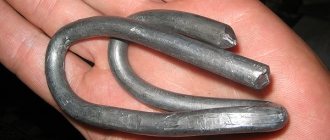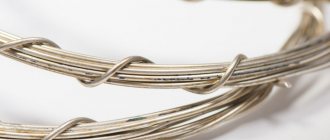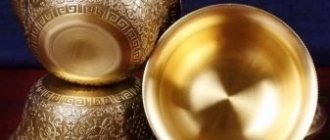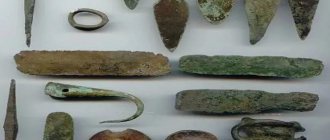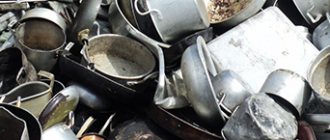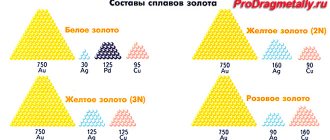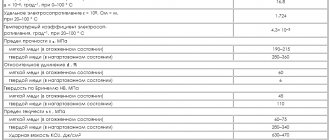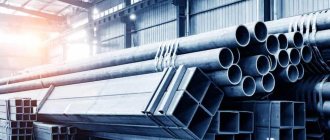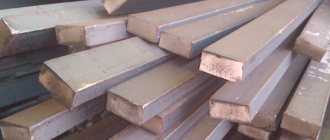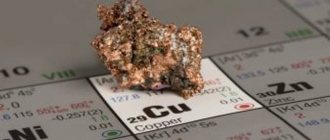Brass LS59-1 is a multicomponent copper alloy, the chemical composition of which is specified by GOST 15527-2004. This GOST indicates that such an alloy may contain 57–60% copper, 37.05–42.2% zinc and 0.8–1.9% lead. Other chemical elements present in the LS59-1 alloy as impurities may be contained in it in an amount of no more than 0.75%.
Brass ingots brand L59-1 are intended for subsequent processing
Although the alloy of this brand belongs to the category of brass, which is well processed by pressure, most often products made from it are processed on high-speed metal-cutting machines. Because of this, LS59-1 is also classified as an automatic weapon. The characteristics of brass of this brand are determined by lead, which is included in its composition as an alloying element.
You can familiarize yourself with the GOST requirements for brass alloys by downloading the document in pdf format from the link below.
GOST 15527-2004 Copper-zinc (brass) alloys processed by pressure. Stamps
Mechanical characteristics
Due to the presence of lead in the composition of LS59-1 brass, when processing products made from it by cutting, small chips are formed, which allows such processing to be performed at high speeds. A distinctive feature of the alloy in question is that lead constitutes a separate phase in its internal structure. This makes such a material highly susceptible to plastic deformation. Meanwhile, if we compare LS59-1 brass with two-component alloys, it is significantly inferior to them in its ductility, so it is better to process such material by cutting.
The range of products made from LS59-1 brass includes:
- rods with different cross-section profiles;
- sheet material – strips, sheets, plates;
- wire;
- profile rolled products;
- pipe products.
Main characteristics of L59-1 brass
Brass of the LS59-1 brand is distinguished by good anti-friction characteristics, which allows the use of such material for the manufacture of products operated in conditions of high friction. From this alloy, in particular, sliding bearings are produced, used to complete various mechanisms and machines. In addition, the abrasion resistance that LS59-1 is characterized by allows this brass to be used for the manufacture of guides for machine tools for various purposes.
Technological properties of alloy L59-1
Since brass of this brand has a multiphase structure, products made from it are characterized by increased fragility. Parts made from LS59-1, on which surface cuts are made, cannot be used as load-bearing elements, since they can break under significant pressure. In addition, the increased fragility of this brass leads to the fact that when exposed to shock loads, the surface of products made of this material can become covered with cracks, which does not allow them to be processed using such a technological operation as forging.
Decoding the brand of alloy LS59-1 and its characteristics
The LS59-1 brand is deciphered as follows: LS - lead brass, in which the percentage of copper is up to 60%. The alloy also contains iron, phosphorus, antimony, and bismuth. Brass chemical composition is regulated by GOST 15527-2004. Compliance with established standards allows us to produce high-quality and durable alloy LS59-1, which has the following technical characteristics:
- Electrical and thermal conductivity;
- resistance to abrasion and corrosion processes;
- anti-friction qualities;
- the ability to process material on cutting machines;
- specific electrical resistivity.
Despite its resistance to deformation and excellent performance, LS59-1 brass is a brittle material. Increased pressure on the metal product can cause fractures at bends or cuts. That is why this alloy is not recommended for use in load-bearing structures and products that will be subject to heavy loads.
The cost of rolled brass is not high, which allows it to be used for the production of various structures and spare parts.
Corrosion resistance
Due to the presence of lead in the chemical composition of brass of the brand in question, a separate phase is formed in its internal structure, which has a positive effect not only on its workability, but also on its resistance to corrosion. Compared to other brass alloys, LS59-1 is more resistant to corrosion. Products made from such brass are not subject to cracking and oxidation when used in conditions of high humidity and temperature changes.
However, there is no need to talk about the exceptionally high corrosion resistance of LS59-1: in this parameter, this alloy is similar to brasses of other brands. In particular, it is not recommended to use it in cases where it will come into contact with products made of iron, aluminum and zinc. In addition, the corrosion resistance of LS59-1 will be poor when:
- simultaneous exposure to high humidity and high pressure;
- contact with fatty acids;
- operation in hydrogen sulfide environment;
- contact with ore waters and mineral acids;
- constant interaction with oxidized solutions and chlorides.
The characteristics of brass allow the metal to be used for the production of shut-off and connecting valves operated at temperatures above 100 degrees
LS59-1 demonstrates its corrosion resistance well under the following operating conditions:
- atmospheric air, including that saturated with sea salt vapor;
- dry steam;
- liquid medium characterized by a very low content of salts and acids;
- freon, alcohol solutions and antifreeze;
- salty sea water in a sedentary state.
It should be borne in mind that the interaction of LS59-1 brass with a gaseous or liquid medium characterized by a high content of ammonia, oxygen and carbon dioxide has a very negative effect on the corrosion resistance of the alloy.
Rental products
Various rolled metal products are manufactured from the brass of the brand in question, the requirements for the chemical composition and mechanical characteristics of which are specified by GOST 15527-2004. The range and parameters of the latter are regulated by other regulatory documents. Pipes for the manufacture of which this alloy is used can be produced either by plastic deformation or by continuous casting. At the same time, the production of pipes from brass LS59-1 by casting is much cheaper than the production of similar products obtained using deformation processes.
Brass pipe is easy to install by welding or soldering
The plastic deformation method for brass of this grade is used in the production of wire and rods, which can have a round, hexagonal or square cross-section. In this case, the manufacturing material itself must also meet the requirements established by GOST 15527-2004 (for products that are made from it, the standards are specified by GOST 1066).
Sheets are produced from LS59-1 brass, characterized by high density, hardness and, accordingly, wear resistance. Due to their characteristics, they are successfully used in the manufacture of guide machines for various purposes. In addition, special technologies make it possible to produce soft, semi-hard and hard sheet materials from such brass. In this case, both the density and specific gravity of such products will correspond to similar parameters of the source material.
Brass sheets are used to make plumbing and electrical products, cladding panels and signs
Rods with different cross-sectional shapes made from LS59-1 brass are very actively used in industry. Their distinctive features are high strength and good machinability. It is also important that the production of such products (for this purpose, rolling or drawing technology can be used) is characterized by low cost. Depending on the manufacturing technology and scope of use, rods made of LS59-1 brass can be produced in soft, semi-hard or hard versions.
Mechanical properties of L59-1 brass rods
Properties of LS59-1
Mechanical properties differ for different semi-finished products due to the production method of LS59-1 brass.
Mechanical properties of LS59-1 at T=20oC
| Assortment | sв — Short-term strength limit | d5 — Elongation at break |
| MPa | % | |
| Pressed pipes, GOST 494-90 | 390 | |
| Pressed rod, GOST 2060-2006 | 360 | 22 |
| Solid rod, GOST 31366-2008 | 490 | 7 |
| Soft rod, GOST 31366-2008 | 330 | 25 |
| Soft wire, GOST 1066-90 | 340 | 25-30 |
| Solid wire, GOST 1066-90 | 440-640 | 1-8 |
| Cold-rolled hard strip, GOST 931-90 | 460-610 | 5 |
| Cold rolled soft strip, GOST 931-90 | 340-470 | 25 |
| Hot rolled strip, GOST 931-90 | 360-490 | 18 |
In reality, brass rod LS59-1 is produced semi-solid according to automatic GOST.
Brass wire LS59-1 is produced both hard and soft; unlike rods, it can often be replaced with L63 brass. Fur properties of brass rods LS59-1
| Preparation method | Delivery status of bars | Diameter, key number or square side, mm | Tensile strength σв, MPa (kgf/mm2) | Elongation after break % δ5 | Elongation after break % δ10 | Hardness NV - according to Brinell | Hardness HV - Vickers |
| soft rods | From 3 to 50 mm | 330 (34) | 25 | 22 | 80 | 80 | |
| Semi-solid | From 3 to 12 mm | 410 (42) | 10 | 8 | 100 | 121 | |
| Pulled | Semi-solid | From 13 to 20 mm | 390 (40) | 15 | 12 | 100 | 121 |
| Semi-solid | From 21 to 40 mm | 390 (40) | 18 | 15 | 100 | 121 | |
| Solid bars | From 3 to 12 mm | 490 (50) | 7 | 5 | 130 | 171 | |
| Pressed | From 10 to 50 mm | 360 (37) | 22 | 18 | — | 80 | |
| pressed | From 55 to 180 mm | 360 (37) | 22 | 18 | — | 70 |
Foundry and technological properties LS59-1
| Melting point LS59-1 | 900 °C |
| Hot processing temperature LS59-1 | 780 – 820 °C |
| Annealing temperature LS59-1 | 600 – 650 °C |
Areas of use
The wide range of applications of products made from LS59-1 brass is explained by such characteristics as:
- low cost;
- high hardness and strength;
- good machinability;
- wear resistance and corrosion resistance.
All this allows this alloy to be successfully used for manufacturing:
- elements of gear and worm connections;
- bushings and liners for various purposes;
- fastening elements;
- pipe products.
Application
Rolled metal products of various types and parameters are made from brass LS59-1. In this case, plastic deformation or the method of continuous casting is used. The alloy is used to produce sheets that are characterized by increased compaction and wear resistance.
LS59-1 is the main material for creating components and workpieces (fasteners, forgings, industrial fittings, etc.). The most recognizable rolled brass products are rods of various sections, wire and plates. These elements are widely used in mechanical engineering, aircraft manufacturing, construction, food and chemical industries.

